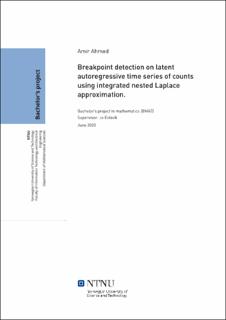| dc.description.abstract | Abrupt changes in a data source can weaken models that fail at addressing these. Structural change detection has traditionally been done with a frequentist approach, but recently approaches based on Bayesian models and Markov Chain Monte Carlo (MCMC) schemes have seen more use. The Integrated Nested Laplace Approximation (INLA) method was developed as a computationally efficient alternative to MCMC sampling. This text experiments with how the INLA approach can be applied in detecting breaks in time series of counts.
It is investigated how different metrics such as, marginal likelihood, comparison of posterior marginals with the L2 norm, and the Deviance Information Criterion (DIC) perform in detecting two types of breaks. The first break type is in correlation structure and the second break type is in the variance structure. The results show that marginal posterior likelihood and DIC perform best when correlation breaks, and that the L2 norm is the best metric of the three with variance structure change.
Lastly the methods presented in this text are used to detect break points in the correlation structure of trading volume data on the TSLA-stock. Two breakpoints were found. | |
